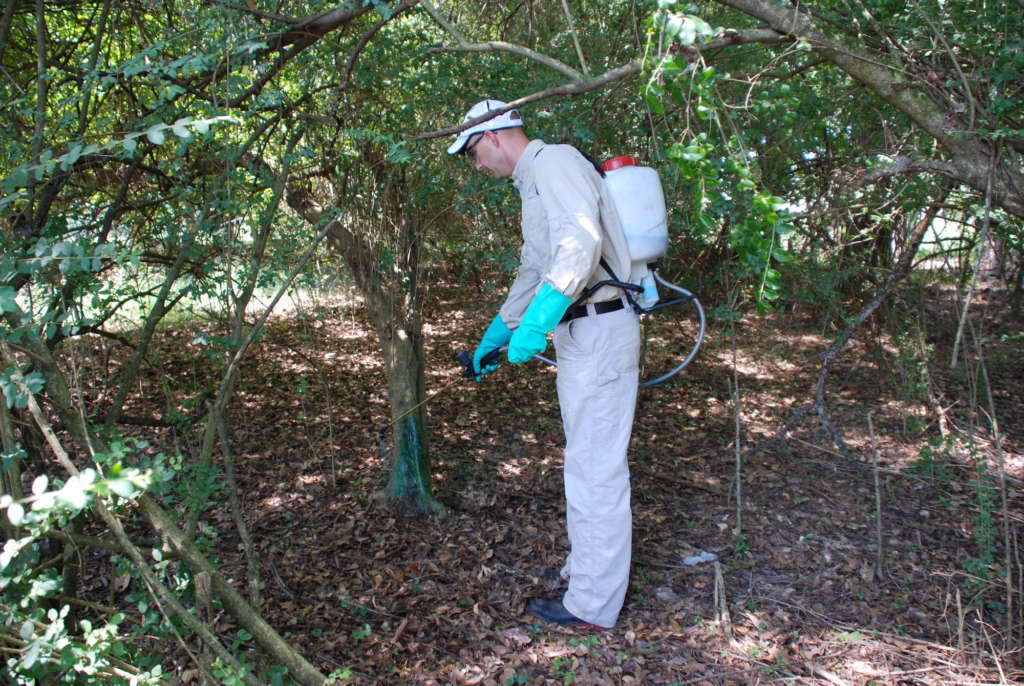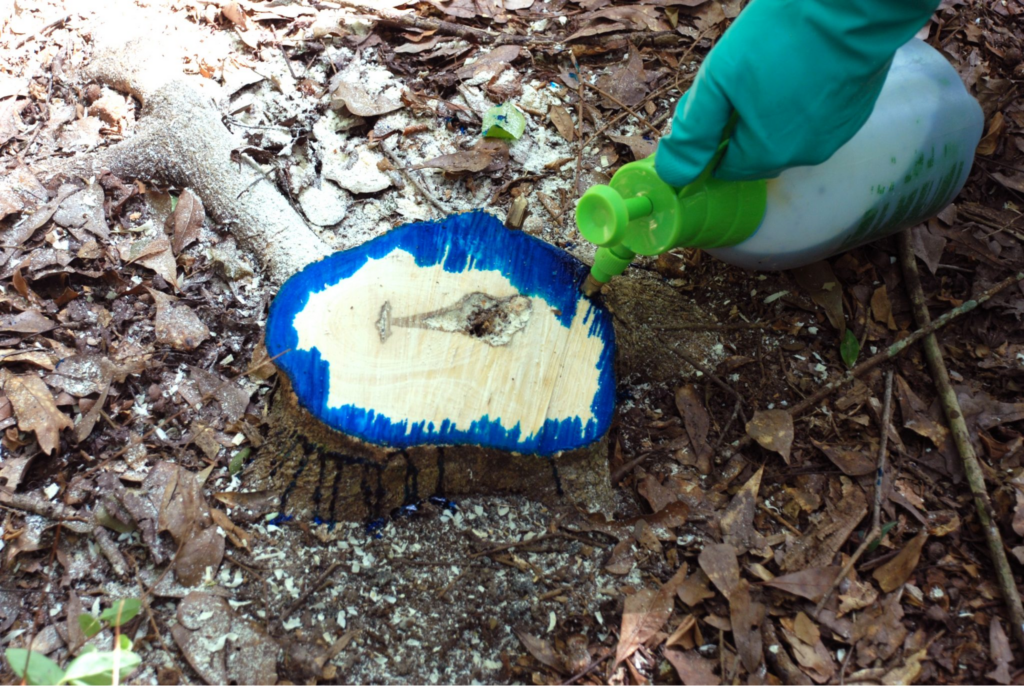
Native to South America, these magnificent beauties known as jacaranda trees are renowned for their mesmerizing purple flowers. However, in certain regions outside their native habitat, jacaranda trees can be considered invasive.
They also possess a knack for spreading aggressively and out-competing native plant species, potentially wreaking havoc on local ecosystems.
If you’re looking to get them off your lawn, then we’ve definitely got the guide for you!
Foliar spray

| Difficulty | Moderate ●●○○○ |
| Method | Chemical |
| Estimated Time for Tree to Die | Weeks to months |
| Ideal Tree Size | Small to medium |
| Things You Need | • Personal protective equipment • Herbicide of choice • Sprayer or preferred applicator |
Foliar spray is one way to tackle those pesky jacaranda trees. In a nutshell, we apply specialized herbicides directly to their leaves, allowing the herbicidal chemicals to penetrate through the leaf surface.
The real game-changer? Systemic herbicides. They infiltrate the entire plant, from roots to branches, leaving no stone unturned.
Timing is key, so we strike during the active growing season when the jacaranda flaunts its leafy glory, ready to absorb herbicides like a sponge. And trust us, it’s best to use top-notch gear to ensure those leaves get the royal treatment.
Once inside, the herbicide disrupts crucial plant processes, hampering photosynthesis and growth regulation. Slowly but surely, it brings about the jacaranda’s demise.
Patience is key though because it takes time, weeks or even months, depending on the tree’s size and health. Also, we recommend that you stick to the manufacturer’s instructions and safety guidelines, mindful of the environment and local regulations.
| How to Do Foliar Spray on Jacaranda Trees 1. Wear the appropriate protective gear. Put on gloves, goggles, and a respirator to shield yourself from potential herbicide exposure. 2. Prepare the tree for removal by choosing a suitable herbicide specifically designed for tree removal. Carefully read and follow the instructions provided by the herbicide manufacturer. Take note of the recommended dosage and application method. 3. Apply the foliar spray. 4. Identify and mark any nearby desirable plants or sensitive areas that should be protected from herbicide overspray. Take precautions to prevent the herbicide from drifting onto unintended targets. You can cover surrounding plants or use a shield during application. It’s advisable to avoid spraying on windy days to minimize herbicide drift. 5. Mix the herbicide. Follow the manufacturer’s instructions and pour the prepared solution into a sprayer. Apply the herbicide evenly to the foliage of the jacaranda tree, ensuring thorough coverage of all leaves. Make sure to achieve complete coverage without excessive runoff or wastage. 6. Monitor the jacaranda tree for signs of decline and eventual death. If regrowth occurs, consider additional treatments or alternative removal methods, such as basal bark treatment or excavation, to ensure complete eradication. 7. Dispose of any pruned branches or trimmed foliage in accordance with local waste disposal regulations. Avoid composting or using the tree parts as mulch, as the herbicide residue may persist and harm other plants. Follow the appropriate guidelines on the herbicide for safe and responsible disposal. |
Basal Bark Treatment

| Difficulty | Moderate ●●○○○ |
| Method | Chemical |
| Estimated Time for Tree to Die | Weeks to months |
| Ideal Tree Size | Small to medium |
| Things You Need | • Personal protective equipment • Herbicide of choice • Sprayer or preferred applicator |
Now, why is basal bark treatment such a hit, especially for our woody friends like jacaranda trees? Well, it’s all about that easy penetration.
The herbicide waltzes its way through the bark, reaching the living tissues beneath. This makes it super effective, especially when the tree is in its growth spree because timing is everything, after all.
The effectiveness of this treatment relies on a few crucial factors.
First, the type of herbicide used can make or break the deal. Second, the size of the tree matters, as it influences the dosage needed.
And finally, when you choose to apply the treatment can have a significant impact. It’s like a well-orchestrated dance routine, you see.
| How to Do Basal Bark Treatment on Jacaranda Trees 1. Put on the appropriate protective gear. These will shield you from any potential herbicide contact or other hazards that might crop up. 2. Scan the surrounding area for any potential hazards. 3. Get the tree ready for removal by clearing away any vegetation or debris around its base. Also, remove any loose or damaged bark from the lower portion of the trunk. This step aids in better absorption of the herbicide. 4. Mix and dilute your chosen herbicide, then apply. Follow the manufacturer’s instructions to mix and dilute the herbicide properly. Using either a sprayer or brush, apply the herbicide evenly to the lower portion of the tree trunk, ensuring that you cover the bark thoroughly up to a height of around 12 to 18 inches. 5. To prevent any regrowth, keep a close eye on the treated tree. Make sure it doesn’t sprout new shoots. If regrowth occurs, you may need to repeat the basal bark treatment or consider alternative methods like excavation or cutting down the tree with cut surface treatment. These measures will help prevent further growth. 6. Dispose of any tree parts, waste, or herbicide containers properly. Check your local regulations and guidelines to ensure you follow the correct disposal procedures. |
Chemical injection

| Difficulty | Moderate to advanced ●●●○○ |
| Method | Chemical |
| Estimated Time for Tree to Die | Weeks to months |
| Ideal Tree Size | Small to medium |
| Things You Need | • Personal protective equipment • Herbicide of choice • Herbicide injection system |
Chemical injection is a little technique employed to bid farewell to those pesky jacaranda trees. Herbicides are injected right into the tree’s trunk or branches, making their way into its complex vascular system.
The end result of this insidious art of tree elimination? A slow decline and eventual demise for our leafy friend!
| How to Do Chemical Injections on Jacaranda Trees 1. Take a careful look around for any risks or obstacles. 2. Make use of protective clothing and equipment to minimize direct contact with herbicides. 3. Evaluate the size and health of the tree to determine the right amount of herbicide needed. Choose the appropriate herbicide based on the tree’s specific requirements and local regulations. Follow the instructions provided by the herbicide manufacturer to correctly dilute the product and apply it at the recommended rates. 4. Identify suitable injection points on the tree, usually located around the trunk or major branches. Employ specialized tools like an injection syringe or a drill with injection capsules to introduce the herbicide into the tree’s vascular system. Make sure to follow the recommended injection depths and spacing to ensure comprehensive coverage. 5. Regularly monitor the treated tree to observe its response to the herbicide. If any new growth or sprouts appear after treatment, promptly remove them. If necessary, implement additional control measures such as follow-up herbicide applications or manual removal. 6. Handle and dispose of pruned branches, leaves, or other tree parts according to the guidelines set by your local authorities. |
Cut Surface Treatment

| Difficulty | Moderate to advanced ●●●○○ |
| Method | Mechanical and chemical |
| Estimated Time for Tree to Die | Weeks to months |
| Ideal Tree Size | Small to large |
| Things You Need | • Personal protective equipment • Chainsaw or ax • Herbicide of choice • Sprayer or preferred applicator |
This method’s a real game-changer because it combines the power of machinery and chemicals to bid adieu to that stubborn jacaranda tree.
First, we physically chop down the tree like a boss. Then, we unleash a dose of herbicides onto the fresh stump or exposed parts of the tree.
These sneaky herbicides seep into the tree’s very essence, putting a stop to any regrowth or pesky sprouting attempts. Boom! And the jacaranda tree is history!
| How to Do Cut Surface Treatment on Jacaranda Trees 1. Wear suitable protective equipment like gloves, safety glasses, and a hard hat. 2. Identify any safety risks such as nearby structures, power lines, or obstacles. 3. Examine the tree to determine the ideal spot for making the cut. Consider factors like the tree’s structure, lean, and the environment surrounding it. 4. Decide the direction in which the tree should fall, ensuring it moves away from any obstacles or structures. 5. Use appropriate tools, such as a chainsaw, to make a controlled cut near the base of the tree. Aim to cut as close to the ground as possible without causing damage to the soil or nearby structures. Always be mindful of the tree’s fall direction and maintain a safe distance during the felling process. 6. Once the tree is felled, apply a suitable herbicide to the freshly cut surface of the stump. Follow the dosage and application method provided by the manufacturer. This will prevent regrowth by allowing the herbicide to penetrate the stump effectively. 7. Remove the felled tree, branches, and other debris from the site. Dispose of these tree parts in accordance with local regulations, which may involve recycling, chipping, or appropriate waste disposal methods. 8. Keep an eye on the treated stump to ensure the herbicide effectively prevents regrowth. If you notice any sprouts or new growth, reapply the herbicide to the cut surface. Regularly inspect the site and promptly remove any potential new growth to prevent the tree from regrowing. |
Girdling or Ring Barking

| Difficulty | Moderate ●●○○○ |
| Method | Mechanical |
| Estimated Time for Tree to Die | Weeks to months |
| Ideal Tree Size | Small to medium |
| Things You Need | • Personal protective equipment • Chainsaw, ax, or chisel |
Girdling or ring barking is a method used to eliminate jacaranda trees by removing a strip of bark from the tree’s trunk. This process disrupts the flow of nutrients and water between the roots and the upper parts of the tree.
By severing the bark and the underlying vascular tissues, girdling effectively starves the tree, leading to its eventual decline and death. It is an approach commonly employed to control or remove unwanted trees, including jacarandas.
| How to Do Girdling or Ring Barking on Jacaranda Trees 1. Assess the area for potential hazards. 2. Wear suitable personal protective equipment. Equip yourself with gloves, safety glasses, and sturdy footwear to protect against potential hazards during the process. 3. Select a section on the trunk where you intend to perform the girdling. 4. Utilize a sharp tool like a chisel or an ax to carefully remove a strip of bark from around the entire circumference of the tree. The width of the strip may vary, but make sure it is deep enough to penetrate the bark and expose the inner layers of the tree 5. After completing the girdling, monitor the tree closely to ensure effective decline. Periodically check for any sprouts or shoots around the girdled area and promptly remove them to prevent regrowth. 6. Dispose of the removed bark, branches, and other tree parts responsibly. Comply with local regulations regarding waste disposal, or explore recycling options if available. |
Excavation

| Difficulty | Advanced to expert ●●●●● |
| Method | Mechanical |
| Estimated Time for Tree to Die | Immediate, depending on skill |
| Ideal Tree Size | Small to medium |
| Things You Need | • Personal protective equipment • Excavators or backhoes |
| How to Do Excavation on Jacaranda Trees 1. Conduct a thorough assessment of the surrounding area to identify potential hazards. Take note of nearby structures, utilities, or overhead power lines that may pose a risk. To prioritize safety, implement appropriate measures, such as barricading the work area and utilizing warning signs if necessary. 2. Wear suitable protective equipment. This includes helmets, gloves, safety glasses, and sturdy footwear. 3. Begin by pruning the jacaranda tree, removing any branches or foliage that could impede the excavation process. This step allows for easier access to the tree and facilitates a smoother removal process. 4. Use heavy machinery, like excavators or backhoes, to excavate around the base of the tree with caution. Gradually expose the root system while ensuring a systematic approach. This method maintains the stability of the surrounding soil and minimizes any potential damage to nearby structures or utilities. 5. Once the tree has been removed, ensure proper disposal of all tree parts and debris. This can involve chipping branches and trunk sections for mulch or transporting them to designated disposal sites. Stick to local regulations regarding the disposal of green waste. 6. After the excavation is complete, apply herbicides to the exposed stump or utilizing a stump killer to help prevent resprouting. Be diligent in monitoring the area for any new growth and address it promptly to ensure the complete removal of the jacaranda tree. |
FAQs
Jacaranda trees generally have deep and extensive root systems. Their roots can penetrate deep into the soil, allowing the tree to access water and nutrients from lower layers.
However, the exact depth and spread of the roots can vary depending on soil conditions and other factors.
Jacaranda trees have a typical lifespan of around 50 to 70 years, although some well-maintained trees can live longer.
The longevity of a jacaranda tree depends on various factors, including environmental conditions, disease susceptibility, and proper care and maintenance.
You can propagate jacaranda trees from cuttings. Softwood or semi-hardwood cuttings taken from healthy jacaranda branches can be used for propagation.
However, it’s important to note that successful rooting and growth of cuttings can vary, and proper techniques and care are necessary for successful propagation.
Jacaranda flowers are not considered poisonous to humans. They are non-toxic and generally safe.
However, it’s always a good practice to avoid ingesting any plant material unless you are certain of its safety. If you have specific concerns or allergies, it’s advisable to consult with a medical professional.




